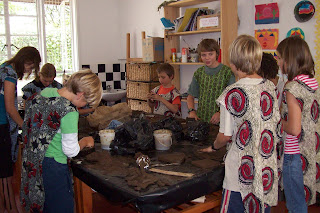Below is a photo update of the paper installation above Fatma's desk in the front room. Soon I will take it down and we will begin again with a new piece.
In the Saturday class we have been exploring proportion and scale. We began with careful looking in the banana grove, considering our perception of scale and how it changes as we move our bodies through space. It was really satisfying to see each student's understanding evolve over the course of an hour.
These two students are working with wire to measure and construct small scale versions of themselves. Tomorrow we will build a village for these figures. Beyond discussion of technical objectives, I aim to touch on what it is that each of us needs and wants in a home, and how these ideals are manifested in our lives personally and as members of a village or community.
Check out those smocks!
This is the Thursday class. Some of the students pictured are actually from northeastern Ohio! It was surreal to sit in the front room of Umoja and look down to see a pair of OSU Buckeye branded sandals on a new student.
Yesterday, this group finished clay projects that will be fired in a village 20 minutes away on Tuesday.
(finished student work drying)
Shanna (another art teacher) and I found ourselves lost on a clay hunt a couple of weeks ago. We were driving to an area called Usa, and had almost lost hope of finding our destination when along the side of the road, a woman stood with a splay of fired pots. It seemed like a good sign, and we stopped to ask her where we could find clay like hers. She told us we would have to drive 40 more minutes to get clay if we wanted it, because the area we were in had "run out" of its clay reserves. Shanna then asked her about a mama who used to operate a women's pottery group, and the woman directed us just a little further down the road to the left. We took off driving again, and found the turn-off she had mentioned. Quickly we transitioned from highway, to driving on a mud road surrounded by corn and school kids in gray uniforms. We drove for another five minutes, and came across a group of women carrying wood. Again, we asked for directions. According to the women,we were on the right track, we just needed to go a little further...
We eventually found ourselves at a school with a large kiln in the backyard. That seemed like a sure-fire sign, so we pulled off and asked around. We finally found our way to Mama Anna, who filled us in on the status of the women's pottery operation. Apparently there was a dispute, and the whole thing had disbanded. She hadn't had any reason to make clay or fire anything for some time, but she offered her own small clay reserve as well as her assistance in firing finished pieces from Umoja. Wow.
After a little more discussion, she took us to her house further up the mountain. The road was again narrow, crowded with more corn, banana trees and the occasional person. We arrived, and were taken to the side of the goat stable, beneath which Mama Anna keeps her bags of clay. She grabbed one, pulled out a clump of prepared clay, and was quickly on her way to demonstrating how she makes a cooking pot. It turns out a lot of people make their pots on the ground, but from a standing position. As she demonstrated, Mama Anna was bent at the waist, arms elongated, and walking slowly around the clay ring adding coils. Meanwhile, the whole family had gathered and formed something of an assembly. In the end, everyone was looking at each other smiling and nodding.
To get the clay, Mama Anna has to hike a long ways, dig it out of the ground and carry it on her hike back. Beyond that, she has to sift it, add a fine sand and then water before it is a proper wet mix. Knowing the person who has gone to such lengths for a material we are using in class causes me to be more conservative, making sure we recycle each scrap, and to encourage students to put their best efforts in their work. We have used two batches of Mama Anna's mix for this project, and I am really looking forward to returning to Usa to work with her Tuesday!
















